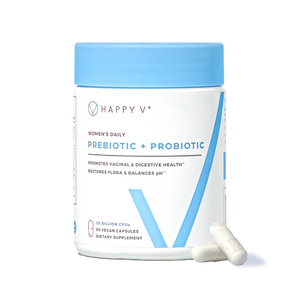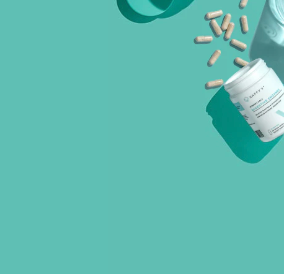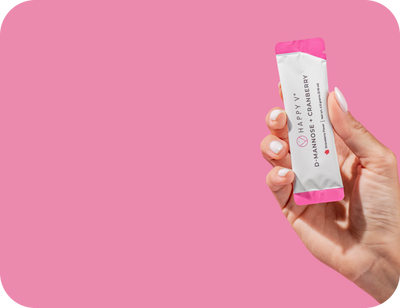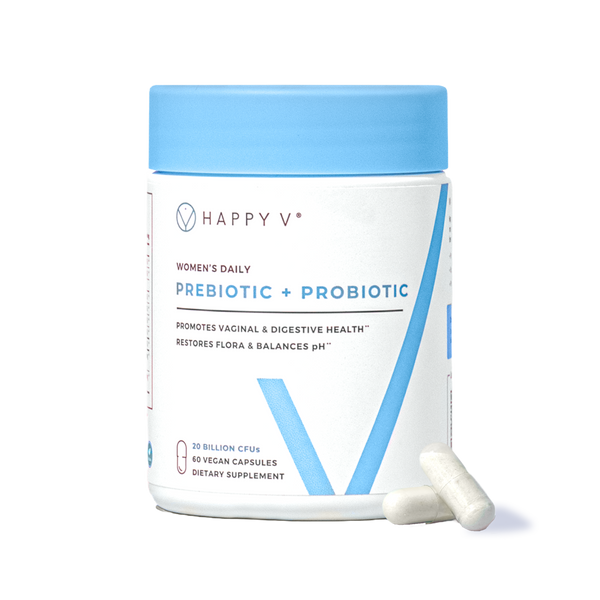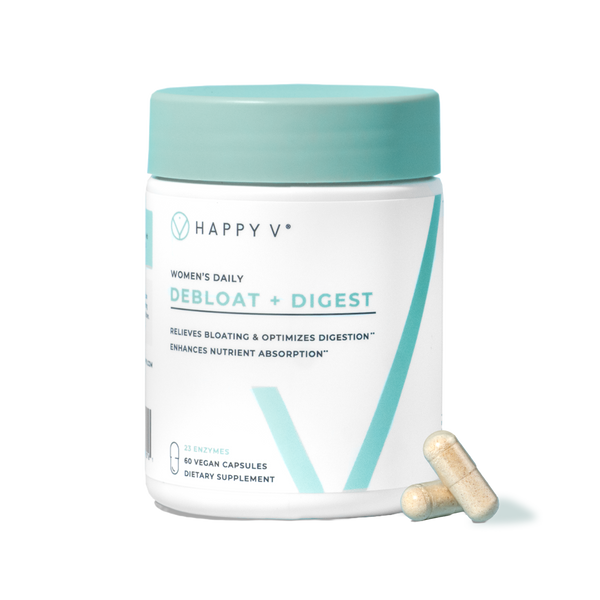- Fact Checked
- September 20, 2025
- 12 min read
Cramping But No Period: Causes And Next Steps
Table of Contents
Table of Contents
You're lying in bed, and there it is again, that familiar cramping sensation low in your abdomen. But here's the thing: your period isn't due for another two weeks. So what the heck is going on?
The truth is, cramps aren't exclusively a "period thing,"1 even though we've been conditioned to think they are. Your body is incredibly complex, and cramping can happen for dozens of reasons that have nothing to do with your monthly cycle. Sometimes it's completely harmless, other times it's your body's way of flagging something that needs attention. The key is learning to decode what your body might be trying to tell you.
This post is for informational purposes only and does not constitute medical advice. See full disclaimer below.
Why You Shouldn’t Ignore Cramping
Cramping, especially if it’s outside your monthly period, isn’t just background noise from your body. It’s a signal worth paying attention to.
Sometimes the reason is simple, like stress tightening your pelvic floor, dehydration making muscles spasm, or a tough workout leaving your core sore. But other times, cramps are your body’s early alert system for bigger issues (think: hormonal changes, ovarian cysts, endometriosis, infections, or even the first signs of pregnancy)2.
Brushing off cramps without investigating can delay you from getting answers or relief. Tuning into patterns like when they happen, how they feel, and what comes with them— an help you catch problems earlier and get the right treatment faster.
Your body isn’t trying to trip you up; it’s trying to keep you informed. Ignoring it means missing out on crucial information about your health.
Common Reasons for Cramping Without a Period
These are the common culprits for cramping that most people experience at some point in their lifetime. They're usually manageable and often resolve on their own with proper care.
Ovulation Pain (Mittelschmerz)
Around the middle of your cycle, you might experience sharp, one-sided pain that medical folks call mittelschmerz (literally "middle pain" in German).
This happens when your ovary releases an egg, and for some people, it's as noticeable as period cramps themselves. The pain typically lasts anywhere from a few minutes to a few hours and alternates sides depending on which ovary is ovulating that month.
Early Pregnancy Cramping
Early pregnancy cramping can feel remarkably similar to period cramps, which is why it often flies under the radar initially.
Your uterus is essentially doing construction work, expanding and adjusting to accommodate new life, and that process can definitely be felt. If you're experiencing cramping alongside breast tenderness, fatigue, nausea, food aversions, spotting, or a missed period, your body might be announcing some big news.
Lifestyle-Related Cramping
Your daily habits play a huge role in how your body feels, and sometimes cramps have more to do with muscle tension than hormones or medical conditions.
Here are some common ways your lifestyle can lead to cramping:
- Stress: High stress levels can cause your pelvic floor muscles (aka the hammock of muscles that support your pelvic organs) to tighten and spasm. Many of us hold tension in our pelvic area without even realizing it, and when those muscles seize up, the pain can mimic menstrual cramps.
- Hormonal shifts: Fluctuations throughout your cycle can also trigger pelvic floor spasms, which feel a lot like period cramps even when you’re not bleeding3.
- Dehydration: When you’re not drinking enough water, muscles throughout your body—including the pelvic floor—are more prone to spasms and cramping.
- Exercise: Intense workouts, especially core exercises, can leave pelvic floor muscles sore or in spasm, leading to cramping that feels like it’s coming from your reproductive system.
The good news is that lifestyle and pelvic floor–related cramping is often very treatable. Staying hydrated, managing stress, and gentle stretching can all help. And for ongoing issues, a specialized pelvic floor physical therapist can teach exercises that reduce spasms and improve long-term comfort.
Digestive Issues
Here's a plot twist that surprises many people: sometimes pelvic cramping has absolutely nothing to do with your reproductive system4. Your digestive system is right there in the neighborhood, and it's not always a quiet neighbor5.
Common digestive issues associated with cramping include:
-
Irritable Bowel Syndrome (IBS). IBS is a master of disguise, often causing cramping, bloating, and pain that can feel identical to period cramps. The cramping typically coincides with changes in bowel movements (either constipation or diarrhea).
-
Food intolerances. Intolerances like lactose intolerance or gluten sensitivity can trigger spasms after meals that register as cramping in your lower abdomen. The timing (usually 30 minutes to 2 hours after eating trigger foods) is often the giveaway.
- Inflammatory Bowel Disease (IBD). This includes conditions like Crohn’s disease and ulcerative colitis. These conditions involve chronic inflammation of the digestive tract, and flare-ups may bring sharp or persistent cramps, diarrhea, and sometimes even bleeding. Because symptoms often overlap with gynecological pain, IBD can be mistaken for reproductive issues.
Urinary Tract Issues
Urinary tract infections (UTIs) create their own brand of lower abdominal pressure and pain, often accompanied by burning during urination, frequent bathroom trips, and sometimes cloudy or strong-smelling urine.
Interstitial cystitis, a chronic bladder condition, can cause similar symptoms that come and go unpredictably.
Less Common But Important Causes
These conditions are less frequent but can significantly impact your quality of life if left unaddressed. They often require medical evaluation and targeted treatment.
Endometriosis
Endometriosis is probably the most notorious impostor when it comes to non-menstrual cramping and one of the most significant health conditions affecting women's health.
This condition causes tissue similar to your uterine lining to grow in places it shouldn't (think: on your ovaries, fallopian tubes, or other reproductive organs). This creates severe cramps and pelvic pain that can strike at any time during your menstrual cycle, often getting worse over time. The abdominal cramping might be accompanied by pain during intercourse, heavy periods when they do occur, back pain, and sometimes digestive issues.
Many people with endometriosis also experience symptoms similar to IBS, including bloating and changes in bowel movements.
Polycystic Ovary Syndrome (PCOS)
PCOS throws your hormones into chaos, often resulting in irregular cramping alongside other symptoms like irregular periods, weight changes, excess hair growth, and acne.
The cramping often stems from enlarged ovaries or cysts, and the hormonal imbalances can affect everything from your mood to your energy levels.
Ovarian Cysts
Most ovarian cysts are harmless and resolve on their own6, but larger ones can definitely make their presence known through sharp, one-sided pain that comes and goes unpredictably. Sometimes the pain is dull and constant; other times it's sharp and sudden, especially if a cyst ruptures or causes the ovary to twist7.
Uterine Fibroids
Fibroids are non-cancerous growths in or around the uterus that can create pressure and cramping that doesn't follow any menstrual schedule8. Depending on their size and location, they might also cause heavy bleeding during periods, frequent urination, or a feeling of fullness in your lower abdomen.
Pelvic Inflammatory Disease (PID)
PID is an infection of the reproductive organs that can cause cramping along with fever, unusual discharge, and pain during intercourse. It's often caused by sexually transmitted infections that have spread from the vagina to the upper reproductive tract9.
Intrauterine Device (IUD) Effects
If you have an IUD, mild cramping can be part of your new normal10, especially in the months following insertion as your body adjusts to its presence. Most people find this settles down after a few months, but some continue to experience occasional cramping.
Appendicitis
Appendicitis typically starts as vague cramping around the belly button11 before developing into sharp, localized pain in the lower right abdomen. This one's definitely not a "wait and see" situation. It requires immediate medical attention.
Adenomyosis
Similar to endometriosis12, adenomyosis involves tissue growing where it shouldn't, but in this case, the uterine lining grows into the muscle wall of the uterus itself. This can cause severe cramping, heavy bleeding, and an enlarged uterus.
Figuring Out the Source of Your Cramps
Cramps can feel mysterious, but your body usually gives you a trail of clues. You just have to notice them.
When it comes to tracing the source of your discomfort, remember:
- Timing matters. If the pain shows up mid-cycle, it could be ovulation. If it hits after a missed period, pregnancy might be on the table. If it happens after certain meals, your gut could be the real culprit.
- Location gives hints. Sharp, one-sided pain? That might be an ovarian cyst or ovulation. A more spread-out, hard-to-pinpoint ache often points toward endometriosis or digestive issues.
- Check the “plus ones.” Fever or unusual discharge often signal infection. Heavy bleeding can mean fibroids or hormonal changes. Digestive issues alongside cramping may suggest IBS or IBD. Burning or pain when you pee? Likely urinary tract involvement.
- Severity and duration are key. Quick, mild cramps that pass aren’t usually a big deal. But pain that’s strong, sticks around, or messes with your daily life? That’s your cue to call a healthcare provider.
The bottom line: don’t just note that you’re cramping. Track when it happens, how it feels, and what comes with it. That info can help you and your healthcare provider figure out if it’s a harmless blip or something worth checking out.
For more information on how to observe changes before and during your menstrual cycle, check out our guide on Cycle Tracking 101: Why Monitoring Your Period Matters for Your Health.
Finding Relief That Actually Works
When cramping strikes, you don’t have to just grit your teeth and wait it out. There are plenty of strategies, from quick fixes to long-term support, that can make a real difference.
Immediate Relief Strategies
If cramps are interfering with your ability to get through the dry, try:
- Heat therapy: A heating pad on your lower abdomen or a warm bath helps relax tense muscles and boost blood flow, breaking the pain–spasm cycle.
- Herbal teas: Chamomile, peppermint, and ginger tea have natural anti-inflammatory and muscle-soothing properties. Red raspberry leaf tea is often used for reproductive health support.
- Gentle movement: Light yoga, stretching, or a short walk increases circulation and eases muscle tension—especially in the pelvic floor and lower back.
- Over-the-counter pain relief: NSAIDs like ibuprofen reduce inflammation at the source, not just the pain. Take with food to protect your stomach.
Nutritional Support for Hormonal Balance
If you have PCOS, are in perimenopause, or have other reason to believe your cramping is associated with hormonal balance, focus on:
- Anti-inflammatory foods: Omega-3 rich salmon, walnuts, leafy greens, and berries can naturally reduce cramping. Even dark chocolate (in moderation) has benefits.
- Magnesium-rich foods: Dark leafy greens, nuts, seeds, and whole grains support proper muscle contraction and relaxation.
- Hydration: Staying well-hydrated helps prevent muscle spasms and supports overall pelvic health.
Targeted Supplements
For those dealing with ovarian-related cramping from PCOS, cysts, or hormone imbalance, targeted supplements can help. Happy V’s Ovarian Support is designed to balance hormones and support ovarian function with clinically studied ingredients that work on multiple pathways, like:
- Inositol: Helps regulate hormones and support healthy ovarian function, especially for those with PCOS.
- Spearmint extract: Naturally lowers excess androgens linked to acne, hair growth, and irregular cycles.
- Vitamin D3: Supports hormone regulation; many with reproductive health issues are deficient.
- N-Acetylcysteine (NAC): Supports ovarian health and may reduce cyst formation.
- Chromium: Improves insulin sensitivity, which is often tied to PCOS and irregular cycles.
Together, these ingredients work to reduce inflammation, regulate hormones, and improve cycle regularity, helping to ease cramping and boost overall reproductive wellness.
Long-Term Reproductive Health Support
If lifestyle is contributing to your cramps, key changes that can lead to improvements include:
- Stress management: Chronic stress raises cortisol, which disrupts hormones13. Try meditation, journaling, or yoga to bring levels back into balance.
- Quality sleep: 7–9 hours a night helps regulate hormone production and reduce cramp frequency.
- Regular exercise: Moderate activity most days of the week supports hormone balance, pelvic health, and stress management.
Professional Treatment Options
Any unexplained cramping should be investigated by a healthcare professional. Once they pinpoint the cause, they may suggest:
- Hormone therapies: May help regulate cycles and reduce cramps for conditions like PCOS or endometriosis.
- Pelvic floor physical therapy: Specialized exercises and techniques target muscle spasms that mimic menstrual cramps.
- Hormonal birth control: Often prescribed to regulate cycles and ease pain from endometriosis or PCOS.
- Surgical options: Sometimes needed for severe endometriosis, large fibroids, or persistent ovarian cysts.
When It's Time to Call in a Healthcare Professional
Most cramping is harmless and manageable at home, but your intuition about your own body is usually spot-on. Trust yourself when something feels different or concerning.
Definitely reach out to a healthcare provider if you're experiencing:
- Severe or sharp pain that doesn't respond to usual relief methods
- Heavy or irregular bleeding alongside cramping
- Fever, chills, or other signs of infection
- Painful urination or persistent UTI-like symptoms
- Unusual discharge with strong odor or unusual color
- Cramps that are interfering with your work, sleep, or daily activities
- Pain during intercourse
- Sudden, severe pain that could indicate a ruptured cyst or appendicitis
Remember, getting a proper diagnosis isn't just about ruling out serious conditions but also understanding your body better and finding targeted relief strategies that actually work for your specific situation.
Final Thoughts
Cramping without a period can be confusing, but it’s also one of your body’s ways of flagging what’s happening beneath the surface. Sometimes it’s as simple as ovulation or stress; other times, it’s a sign to seek medical guidance. Trust your instincts, pay attention to patterns, and don’t hesitate to get support when cramps feel unusual or persistent.
Keep the Conversation Going
-
Visit our blog for more women’s health tips.
-
Join our private Happy V Facebook group to hear from others who’ve been there.
- Explore supplements designed to support your vaginal health journey.
Disclaimer: This blog is for informational and educational purposes only and is not intended to diagnose, treat, cure, or prevent any disease. Statements about supplements have not been evaluated by the Food and Drug Administration. For more information about vaginal infections, visit the CDC or speak to a licensed healthcare provider.
